2017 NISSAN VERSA SEDAN check engine
[x] Cancel search: check enginePage 362 of 404

Underbody:The underbody is frequently ex-
posed to corrosive substances such as those
used on icy roads or to control dust. It is very
important to remove these substances from the
underbody, otherwise rust may form on the floor
pan, frame, fuel lines and exhaust system. At the
end of winter, the underbody should be thor-
oughly flushed with plain water, in those areas
where mud and dirt may have accumulated. For
additional information, refer to the “Appearance
and care” section of this manual.
Windshield-washer fluid*: Check that there is
adequate fluid in the reservoir. The following descriptions are provided to give
you a better understanding of the scheduled
maintenance items that should be regularly
checked or replaced. The maintenance schedule
indicates at which mileage/time intervals each
item requires service.
In addition to scheduled maintenance, your ve-
hicle requires that some items be checked during
normal day-to-day operation. For additional infor-
mation, refer to “General maintenance” in this
section.
Items marked with
“*”are recommended by
NISSAN for reliable vehicle operation. You are
not required to perform maintenance on these
items in order to maintain the warranties which
come with your NISSAN. Other maintenance
items and intervals are required.
When applicable, additional information can be
found in the “Do-it-yourself” section of this
manual. NOTE:
NISSAN does not advocate the use of non-
OEM approved aftermarket flushing sys-
tems and strongly advises against perform-
ing these services on a NISSAN product.
Many of the aftermarket flushing systems
use non-OEM approved chemicals or sol-
vents, the use of which has not been vali-
dated by NISSAN.
For recommended fuel, lubricants, fluids,
grease, and refrigerant, refer to “Recom-
mended fluids/lubricants and capacities”
in the “Technical and consumer informa-
tion” section of this manual.
EMISSION CONTROL SYSTEM
MAINTENANCE:
Drive belts*:
Check engine drive belts for wear,
fraying or cracking and for proper tension. Re-
place any damaged drive belts.
Engine air filter: Replace at specified intervals.
When driving for prolonged periods in dusty con-
ditions, check/replace the filter more frequently.
EXPLANATION OF SCHEDULED
MAINTENANCE ITEMS
Maintenance and schedules9-5
Page 363 of 404

Engine coolant*:Replace coolant at the speci-
fied interval. When adding or replacing coolant,
be sure to use only Genuine NISSAN Long Life
Antifreeze/Coolant (blue) or equivalent with the
proper mixture. (For additional information on the
proper mixture for your area, refer to “Engine
cooling system” in the “Do-it-yourself” section of
this manual.)
NOTE: Mixing any other type of coolant or
the use of non-distilled water may reduce
the recommended service interval of the
coolant.
Engine oil and oil filter: Replace engine oil
and oil filter at the specified intervals. For recom-
mended oil grade and viscosity refer to “Recom-
mended fluids/lubricants and capacities” in the
“Technical and consumer information” section of
this manual.
Fuel lines*: Check the fuel hoses, piping and
connections for leaks, looseness, or deteriora-
tion. Tighten connections or replace parts as
necessary.
Spark plugs: Replace at specified intervals. In-
stall new plugs of the type as originally equipped.CHASSIS AND BODY
MAINTENANCE:
Brake lines and cables: Visually inspect for
proper installation. Check for chafing, cracks,
deterioration, and signs of leaking. Replace any
deteriorated or damaged parts immediately.
Brake pads, rotors, drums and linings:
Check for wear, deterioration and fluid leaks.
Replace any deteriorated or damaged parts im-
mediately.
Exhaust system: Visually inspect the exhaust
pipes, muffler and hangers for leaks, cracks, de-
terioration, and damage. Tighten connections or
replace parts as necessary.
In-cabin microfilter: Replace at specified in-
tervals. When driving for prolonged periods in
dusty conditions, replace the filter more fre-
quently.
Steering gear and linkage, axle and sus-
pension parts, drive shaft boots: Check for
damage, looseness, and leakage of oil or grease.
Under severe driving conditions, inspect more
frequently. Tire rotation:
Tires should be rotated every
5,000 miles (8,000 km) according to the instruc-
tions under “General maintenance” in this sec-
tion. When rotating tires, check for damage and
uneven wear. Replace if necessary.
Transmission fluid/oil: Visually inspect for
signs of leakage at specified intervals.
If towing a trailer, using a camper or car-top
carrier, or driving on rough or muddy roads, re-
place the CVT fluid every 60,000 miles
(96,000 km) or request the dealer to inspect the
fluid deterioration data using a CONSULT. If the
deterioration data is more than 210000, replace
the CVT fluid.
9-6Maintenance and schedules
Page 379 of 404
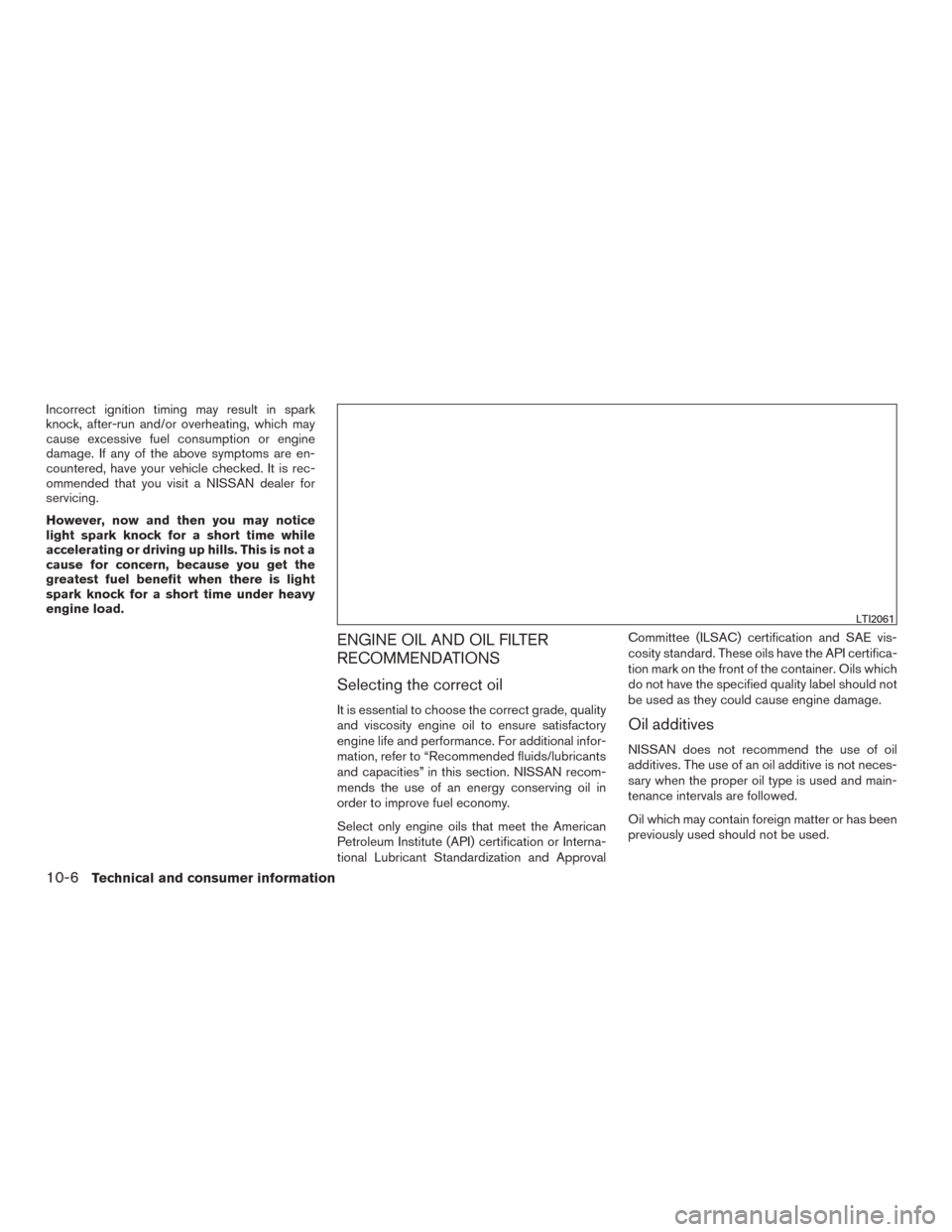
Incorrect ignition timing may result in spark
knock, after-run and/or overheating, which may
cause excessive fuel consumption or engine
damage. If any of the above symptoms are en-
countered, have your vehicle checked. It is rec-
ommended that you visit a NISSAN dealer for
servicing.
However, now and then you may notice
light spark knock for a short time while
accelerating or driving up hills. This is not a
cause for concern, because you get the
greatest fuel benefit when there is light
spark knock for a short time under heavy
engine load.
ENGINE OIL AND OIL FILTER
RECOMMENDATIONS
Selecting the correct oil
It is essential to choose the correct grade, quality
and viscosity engine oil to ensure satisfactory
engine life and performance. For additional infor-
mation, refer to “Recommended fluids/lubricants
and capacities” in this section. NISSAN recom-
mends the use of an energy conserving oil in
order to improve fuel economy.
Select only engine oils that meet the American
Petroleum Institute (API) certification or Interna-
tional Lubricant Standardization and ApprovalCommittee (ILSAC) certification and SAE vis-
cosity standard. These oils have the API certifica-
tion mark on the front of the container. Oils which
do not have the specified quality label should not
be used as they could cause engine damage.Oil additives
NISSAN does not recommend the use of oil
additives. The use of an oil additive is not neces-
sary when the proper oil type is used and main-
tenance intervals are followed.
Oil which may contain foreign matter or has been
previously used should not be used.
LTI2061
10-6Technical and consumer information
Page 393 of 404
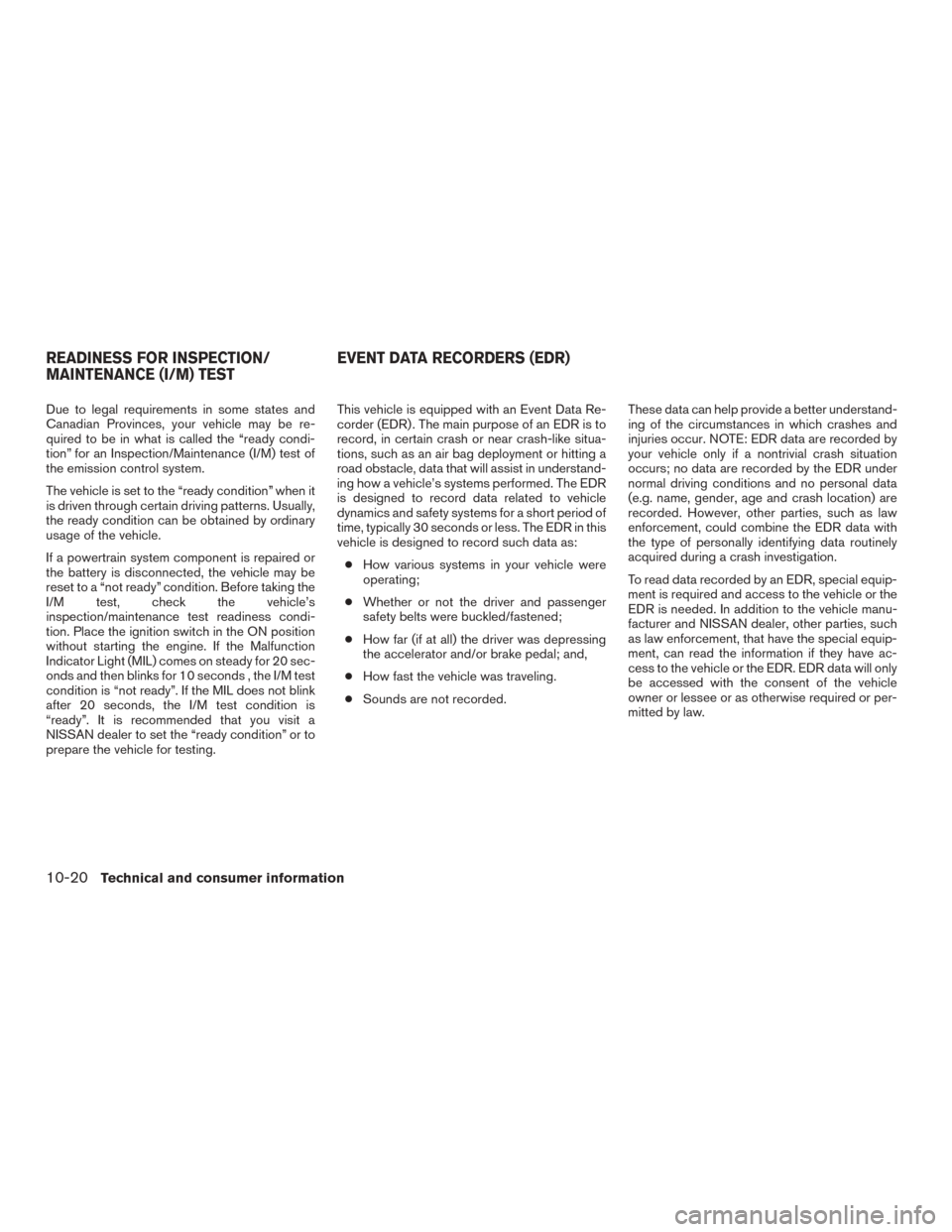
Due to legal requirements in some states and
Canadian Provinces, your vehicle may be re-
quired to be in what is called the “ready condi-
tion” for an Inspection/Maintenance (I/M) test of
the emission control system.
The vehicle is set to the “ready condition” when it
is driven through certain driving patterns. Usually,
the ready condition can be obtained by ordinary
usage of the vehicle.
If a powertrain system component is repaired or
the battery is disconnected, the vehicle may be
reset to a “not ready” condition. Before taking the
I/M test, check the vehicle’s
inspection/maintenance test readiness condi-
tion. Place the ignition switch in the ON position
without starting the engine. If the Malfunction
Indicator Light (MIL) comes on steady for 20 sec-
onds and then blinks for 10 seconds , the I/M test
condition is “not ready”. If the MIL does not blink
after 20 seconds, the I/M test condition is
“ready”. It is recommended that you visit a
NISSAN dealer to set the “ready condition” or to
prepare the vehicle for testing.This vehicle is equipped with an Event Data Re-
corder (EDR) . The main purpose of an EDR is to
record, in certain crash or near crash-like situa-
tions, such as an air bag deployment or hitting a
road obstacle, data that will assist in understand-
ing how a vehicle’s systems performed. The EDR
is designed to record data related to vehicle
dynamics and safety systems for a short period of
time, typically 30 seconds or less. The EDR in this
vehicle is designed to record such data as:
● How various systems in your vehicle were
operating;
● Whether or not the driver and passenger
safety belts were buckled/fastened;
● How far (if at all) the driver was depressing
the accelerator and/or brake pedal; and,
● How fast the vehicle was traveling.
● Sounds are not recorded. These data can help provide a better understand-
ing of the circumstances in which crashes and
injuries occur. NOTE: EDR data are recorded by
your vehicle only if a nontrivial crash situation
occurs; no data are recorded by the EDR under
normal driving conditions and no personal data
(e.g. name, gender, age and crash location) are
recorded. However, other parties, such as law
enforcement, could combine the EDR data with
the type of personally identifying data routinely
acquired during a crash investigation.
To read data recorded by an EDR, special equip-
ment is required and access to the vehicle or the
EDR is needed. In addition to the vehicle manu-
facturer and NISSAN dealer, other parties, such
as law enforcement, that have the special equip-
ment, can read the information if they have ac-
cess to the vehicle or the EDR. EDR data will only
be accessed with the consent of the vehicle
owner or lessee or as otherwise required or per-
mitted by law.
READINESS FOR INSPECTION/
MAINTENANCE (I/M) TEST
EVENT DATA RECORDERS (EDR)
10-20Technical and consumer information
Page 397 of 404
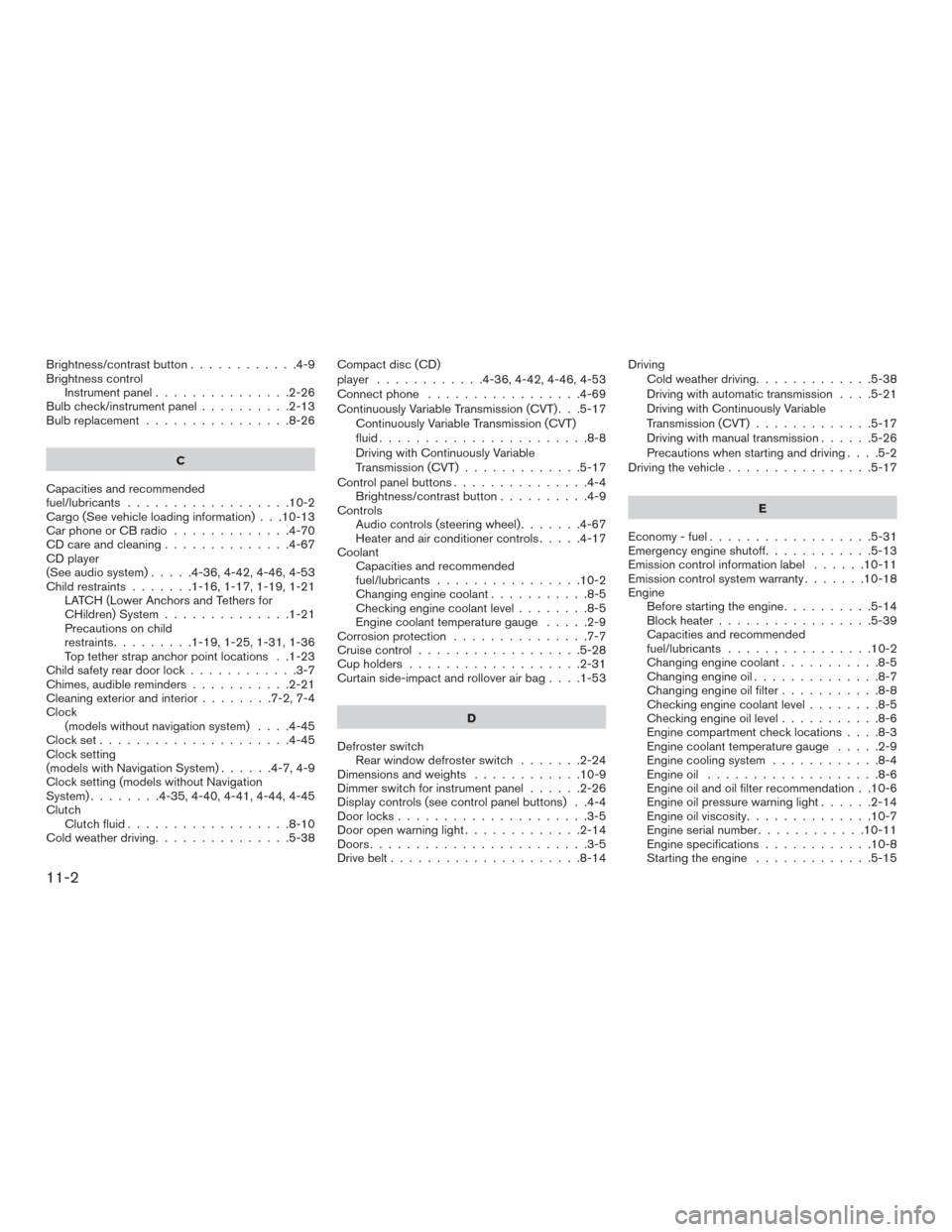
Brightness/contrastbutton............4-9
Brightness controlInstrument panel ...............2-26
Bulb check/instrument panel ..........2-13
Bulb replacement ................8-26
C
Capacities and recommended
fuel/lubricants ..................10-2
Cargo (See vehicle loading information) . . .10-13
Car phone or CB radio .............4-70
CD care and cleaning ..............4-67
CD player
(See audio system) .....4-36,4-42,4-46,4-53
Child restraints .......1-16,1-17,1-19,1-21
LATCH (Lower Anchors and Tethers for
CHildren) System ..............1-21
Precautions on child
restraints.........1-19,1-25,1-31,1-36
Top tether strap anchor point locations . .1-23
Child safety rear door lock ............3-7
Chimes, audible reminders ...........2-21
Cleaningexteriorandinterior........7-2,7-4
Clock (models without navigation system) ....4-45
Clockset.....................4-45
Clock setting
(models with Navigation System) ......4-7,4-9
Clock setting (models without Navigation
System) ........4-35,4-40,4-41,4-44,4-45
Clutch Clutch fluid ..................8-10
Cold weather driving ...............5-38 Compact disc (CD)
player ............4-36,4-42,4-46,4-53
Connect phone
.................4-69
Continuously Variable Transmission (CVT) . . .5-17 Continuously Variable Transmission (CVT)
fluid.......................8-8
Driving with Continuously Variable
Transmission (CVT) .............5-17
Control panel buttons ...............4-4
Brightness/contrast button ..........4-9
Controls Audio controls (steering wheel) .......4-67
Heater and air conditioner controls .....4-17
Coolant Capacities and recommended
fuel/lubricants ................10-2
Changingenginecoolant...........8-5
Checking engine coolant level ........8-5
Engine coolant temperature gauge .....2-9
Corrosion protection ...............7-7
Cruisecontrol..................5-28
Cupholders...................2-31
Curtainside-impactandrolloverairbag....1-53
D
Defroster switch Rear window defroster switch .......2-24
Dimensionsandweights ............10-9
Dimmer switch for instrument panel ......2-26
Display controls (see control panel buttons) . .4-4
Door locks .....................3-5
Door open warning light .............2-14
Doors ........................3-5
Drive belt .....................8-14 Driving
Cold weather driving .............5-38
Driving with automatic transmission ....5-21
Driving with Continuously Variable
Transmission (CVT) .............5-17
Driving with manual transmission ......5-26
Precautions when starting and driving ....5-2
Driving the vehicle ................5-17
E
Economy-fuel..................5-31
Emergency engine shutoff ............5-13
Emission control information label ......10-11
Emission control system warranty .......10-18
Engine Before starting the engine ..........5-14
B l
ockheater.................5-39
Capacities and recommended
fuel/lubricants ................10-2
Changing engine coolant ...........8-5
Changingengineoil..............8-7
Changing engine oil filter ...........8-8
Checking engine coolant level ........8-5
Checking engine oil level ...........8-6
Engine compartment check locations ....8-3
Engine coolant temperature gauge .....2-9
Engine cooling system ............8-4
Engineoil ...................8-6
Engine oil and oil filter recommendation . .10-6
Engine oil pressure warning light ......2-14
Engine oil viscosity ..............10-7
Engine serial number ............10-11
Engine specifications ............10-8
Starting the engine .............5-15
11-2
Page 399 of 404
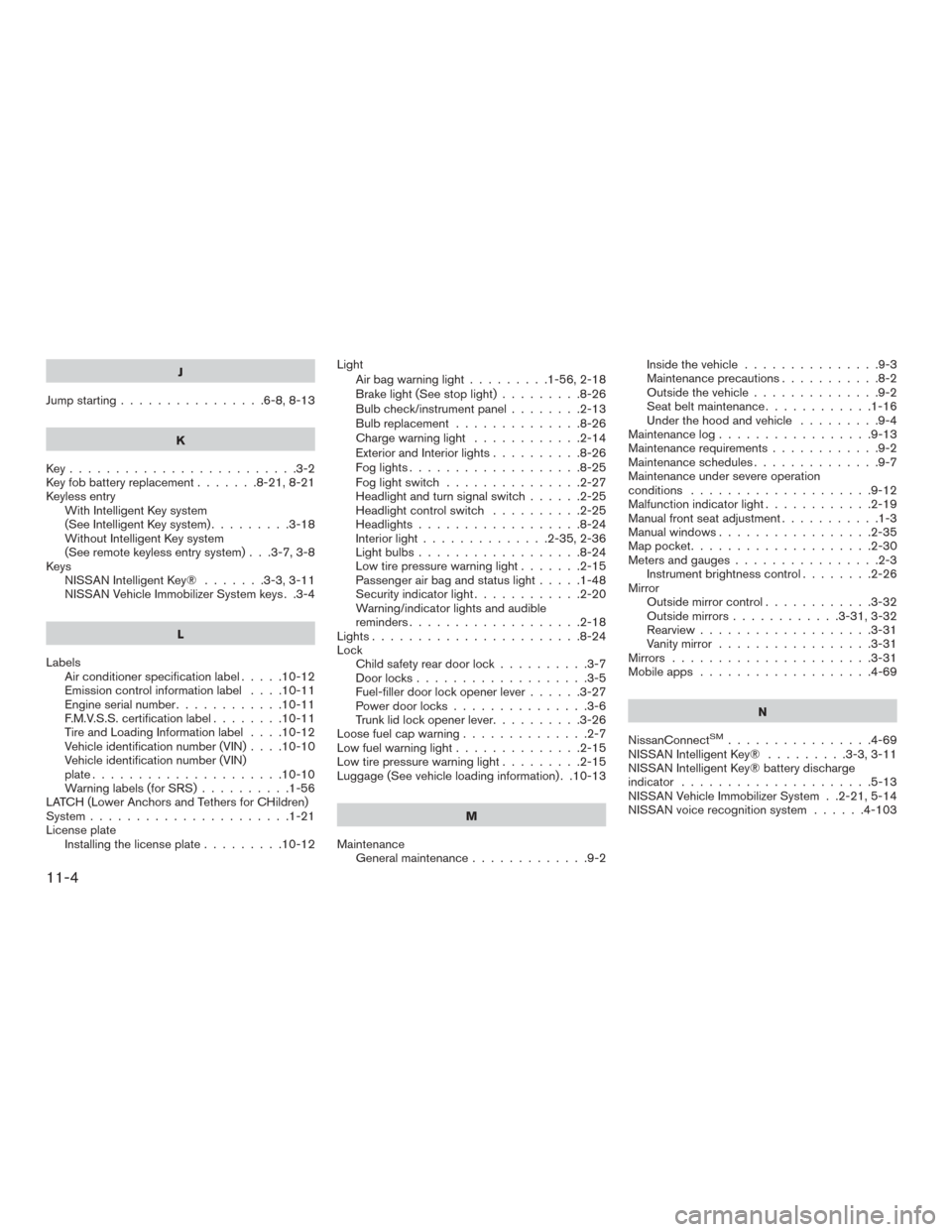
J
Jump starting ................6-8,8-13
K
Key.........................3-2
Key fob battery replacement .......8-21,8-21
Keyless entry With Intelligent Key system
(See Intelligent Key system) .........3-18
Without Intelligent Key system
(See remote keyless entry system) . . .3-7, 3-8
Keys NISSAN Intelligent Key® .......3-3,3-11
NISSAN Vehicle Immobilizer System keys . .3-4
L
Labels Air conditioner specification label .....10-12
Emissioncontrolinformationlabel ....10-11
Engine serial number ............10-11
F.M.V.S.S. certification label ........10-11
Tire and Loading Information label ....10-12
Vehicle identification number (VIN) ....10-10
Vehicle identification number (VIN)
plate .....................10-10
Warning labels (for SRS) ..........1-56
LATCH (Lower Anchors and Tethers for CHildren)
System ......................1-21
License plate Installing the license plate .........10-12Light
Air bag warning light .........1-56,2-18
Brake light (See stop light) .........8-26
Bulb check/instrument panel ........2-13
Bulbreplacement..............8-26
Charge warning light ............2-14
Exterior and Interior lights ..........8-26
Foglights...................8-25
Foglightswitch ...............2-27
Headlight and turn signal switch ......2-25
Headlight control switch ..........2-25
Headlights..................8-24
Interiorlight..............2-35,2-36
Lightbulbs..................8-24
Low tire pressure warning light .......2-15
Passenger air bag and status light .....1-48
Security indicator light ............2-20
Warning/indicator lights and audible
reminders ...................2-18
Lights.......................8-24
Lock Child safety rear door lock ..........3-7
Door locks ...................3-5
Fuel-filler door lock opener lever ......3-27
Power door locks ...............3-6
Trunk lid lock opener lever ..........3-26
Loose fuel cap warning ..............2-7
Lowfuelwarninglight..............2-15
Low tire pressure warning light .........2-15
Luggage (See vehicle loading information) . .10-13
M
Maintenance Generalmaintenance.............9-2 Insidethevehicle...............9-3
Maintenance precautions
...........8-2
Outside the vehicle ..............9-2
Seat belt maintenance ............1-16
Under the hood and vehicle .........9-4
Maintenancelog.................9-13
Maintenance requirements ............9-2
Maintenance schedules ..............9-7
Maintenance under severe operation
conditions ....................9-12
Malfunction indicator light ............2-19
Manual front seat adjustment ...........1-3
Manual windows .................2-35
Mappocket....................2-30
Meters and gauges ................
2
-3
Instrument brightness control ........2-26
Mirror Outside mirror control ............3-32
Outside mirrors ............3-31,3-32
Rearview ...................3-31
Vanity mirror .................3-31
Mirrors ......................3-31
Mobileapps ...................4-69
N
NissanConnect
SM................4-69
NISSAN Intelligent Key® .........3-3,3-11
NISSAN Intelligent Key® battery discharge
indicator .....................5-13
NISSAN Vehicle Immobilizer System . .2-21, 5-14
NISSAN voice recognition system ......4-103
11-4
Page 400 of 404
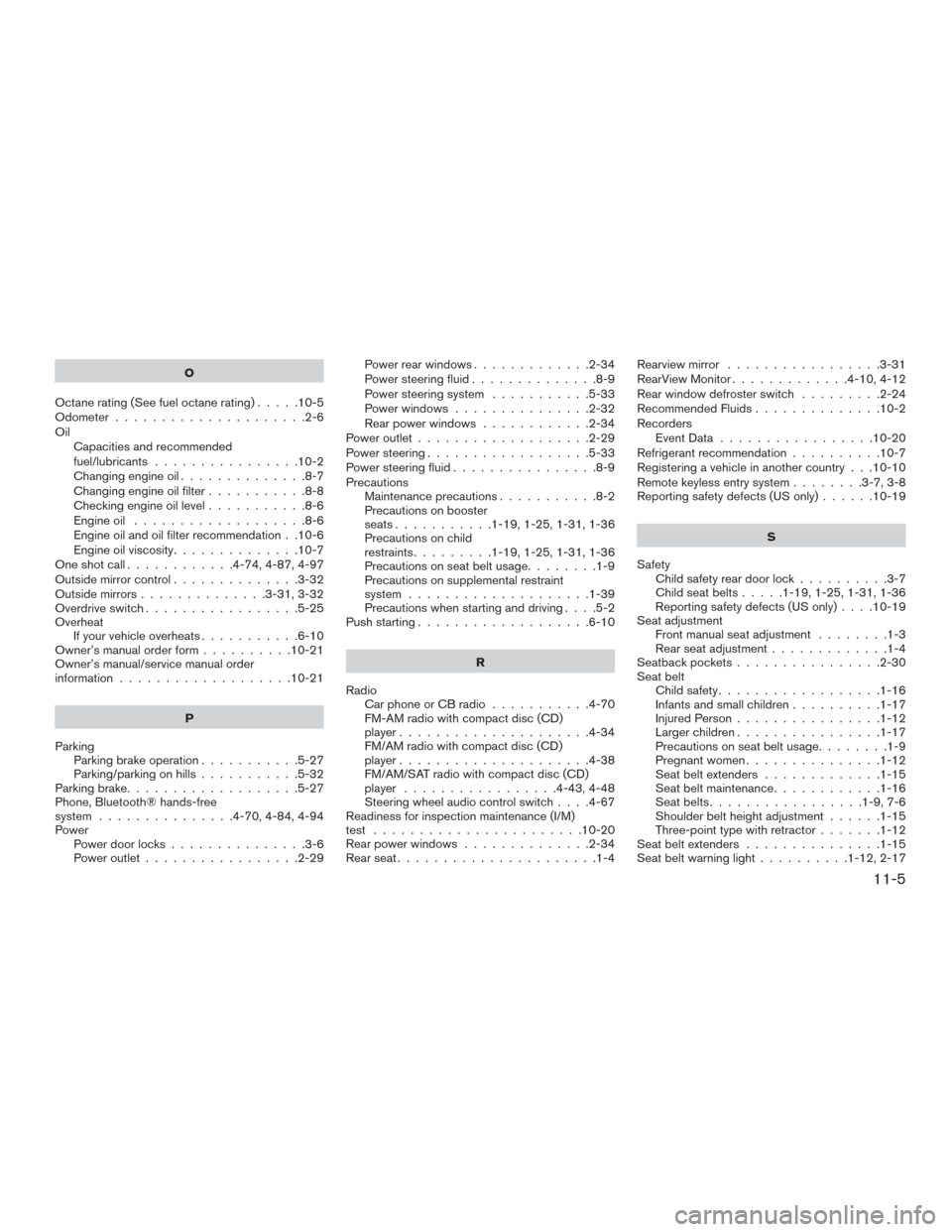
O
Octanerating(Seefueloctanerating).....10-5
Odometer .....................2-6
Oil Capacities and recommended
fuel/lubricants ................10-2
Changing engine oil ..............8-7
Changing engine oil filter ...........8-8
Checking engine oil level ...........8-6
Engine oil ...................8-6
Engine oil and oil filter recommendation . .10-6
Engine oil viscosity ..............10-7
Oneshotcall............4-74,4-87,4-97
Outside mirror control ..............3-32
Outside mirrors ..............3-31,3-32
Overdrive switch .................5-25
Overheat Ifyourvehicleoverheats...........6-10
Owner’s manual order form ..........10-21
Owner’s manual/service manual order
information ...................10-21
P
Parking Parking brake operation ...........5-27
Parking/parking on hills ...........5-32
Parking brake ...................5-27
Phone, Bluetooth® hands-free
system ...............4-70,4-84,4-94
Power Power door locks ...............3-6
Power outlet .................2-29 Power rear windows
.............2-34
Power steering fluid ..............8-9
Power steering system ...........5-33
Power windows ...............2-32
Rear power windows ............2-34
Power outlet ...................2-29
Power steering ..................5-33
Power steering fluid ................8-9
Precautions Maintenance precautions ...........8-2
Precautions on booster
seats...........1-19,1-25,1-31,1-36
Precautions on child
restraints .........1-19,1-25,1-31,1-36
Precautions on seat belt usage ........1-9
Precautions on supplemental restraint
system ....................1-39
Precautions when starting and driving ....5-2
Push starting ...................6-10
R
Radio Car phone or CB radio ...........4-70
FM-AM radio with compact disc (CD)
player .....................4-34
FM/AM radio with compact disc (CD)
player .....................4-38
FM/AM/SAT radio with compact disc (CD)
player .................4-43,4-48
Steering wheel audio control switch ....4-67
Readiness for inspection maintenance (I/M)
test .......................10-20
Rear power windows ..............2-34
Rearseat......................1-4 Rearview mirror
.................3-31
RearView Monitor .............4-10,4-12
Rear window defroster switch .........2-24
Recommended Fluids ..............10-2
Recorders EventData .................10-20
Refrigerant recommendation ..........10-7
Registering a vehicle in another country . . .10-10
Remote keyless entry system ........
3
-7,3-8
Reporting safety defects (US only) ......10-19
S
Safety Child safety rear door lock ..........3-7
Child seat belts .....1-19,1-25,1-31,1-36
Reporting safety defects (US only) ....10-19
Seat adjustment Front manual seat adjustment ........1-3
Rear seat adjustment .............1-4
Seatbackpockets................2-30
Seat belt Child safety ..................1-16
Infants and small children ..........1-17
Injured Person ................1-12
Largerchildren................1-17
Precautions on seat belt usage ........1-9
Pregnant women ...............1-12
Seatbeltextenders .............1-15
Seatbeltmaintenance............1-16
Seatbelts.................1-9,7-6
Shoulder belt height adjustment ......1-15
Three-point type with retractor .......1-12
Seat belt extenders ...............1-15
Seatbeltwarninglight..........1-12,2-17
11-5